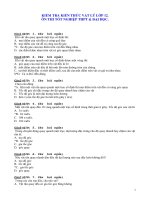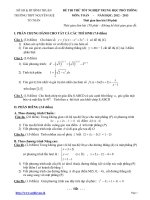COMPUTER NUMERICAL CONTROL PROGRAMMING BASICS phần 1 pdf
Bạn đang xem bản rút gọn của tài liệu. Xem và tải ngay bản đầy đủ của tài liệu tại đây (23.6 KB, 10 trang )
COMPUTER NUMERICAL
CONTROL
PROGRAMMING BASICS
A Primer for the
SkillsUSA/VICA
Championships
Steve Krar Arthur Gill
Distributed to educational administrators,
instructors, students, and apprentices
with the compliments of
INDUSTRIAL PRESS, INC.
publishers of
MACHINERY’S HANDBOOK
“The Bible of the Machine Trades”
CALL FOR AUTHORS
Industrial Press is expanding its list of professional and educational titles in
addition to starting a new program in electronic publishing. If you have any
suggestions or actual writing plans, we encourage you contact us.
We are seeking new authors especially in the following fields:
CNC and CAD/CAM
Design
Electrical/Electronics
Industrial Engineering
Machine Shop/Tools/Metalworking
Maintenance
Manufacturing
Technical Mathematics
Quality Control/Reliability
Welding
Industrial Press provides specialized and personal assistance in all stages of
book publishing from writing the text, to layout, design and marketing. We
give authors the individualized attention needed in producing quality publica-
tions, and actively promote books to national and international markets.
For more information about submitting a proposal, please contact us and we
will forward our suggested guidelines:
John Carleo
Editor
Industrial Press, Inc.
200 Madison Avenue
New York, NY 10016-4078
Toll Free: 888-528-7852 ext. 18
Tel: 212-889-6330 ext.18
Fax: 212-545-8327
www.industrialpress.com
Computer
Numerical
Control
Programming
Basics
Steve Krar Arthur Gill
This book is not intended for sale under any circumstances.
INDUSTRIAL PRESS INC.
200 Madison Avenue, New York, NY 10016
Photo Credits - Allen Bradley, Deckel Maho Inc., Denford Inc., Emco
Maier Corp., Icon Corp., Kelmar Associates, Superior Electric Co.
Development Resources provided by Paul Koontz, Denford Inc.
Page Layout / Design - Coree Kilo Price, Denford Inc.
Library of Congress Cataloging-in-Publication Data
Krar, Steve F.
COMPUTER Numerical Control Programming Basics / Steve
Krar, Arthur Gill.
p. cm.
ISBN 0-07-023333-0
1. Machine Tools - Numerical Control. I. Gill, Arthur, date.
II Title.
TJ1189, K74 1999 89-12571
CIP
Some of the artwork for this book was processed electronically.
Computer Numerical Control Programming Basics
Copyright © 1999 by Kelmar Associates. All rights reserved.
Printed in the United States of America. Except as permitted
under the United States Copyright Act, no part of this
publication can be reproduced or distributed in any form or
means, or stored in a database or retrieval system without the
written permission of the publisher.
Send all inquiries to:
Kelmar Associates
420 Fitch Street, Welland, ON L3C 4W8
Phone: (905) 732-4193 E-mail:
Industrial Press Edition ISBN 0-8311-3131-4
CONTENTS
SECTION PAGE
Foreword 1
Preface 7
Cartesian Coordinate System 7
Machines Using CNC 9
Programming Systems 11
Point-to-Point or Continuous Path 13
Point-to-Point Positioning 14
Continuous Path (Contouring) 15
Interpolation 15
Programming Format 17
Programming for Positioning 23
Work Settings and Offsets 26
CNC Bench-Top Milling and Turning Centers 30
CNC Programming Hints — Milling 32
Milling and Drilling Programming 34
CNC Programming Hints – Turning 38
Fanuc Compatible Programming 39
Turning Programming 40
1
CNC Foreword
As the National Technical Committee Chairman for the Precision
Machining Technology portion of the Skills USA-VICA champion-
ships I get to see students of varying levels of competence com-
pete each year. Each year my Industry committee works very hard
to design a competition that is challenging but fair. Since both
Secondary and Post-Secondary students compete at the Nation-
als, the level of difficulty is always a topic of discussion. Of major
concern are the low scores in the CNC programming sections of
this national competition. Only basic CNC programming skills are
required to complete these portions of the competition. However,
the scores indicate that too many competitors do not have these
basic skills. Because the committee feels a responsibility to help
educators provide this basic knowledge to students interested in
manufacturing technology, the committee suggested that this
booklet be furnished to all Skills USA-VICA State Directors and all
instructors with a machining curriculum in that state.
This book can be photocopied with the written permission from
Kelmar Associates so that as many students as possible can be
exposed to this basic information; It is not for resale. The informa-
tion should also be furnished to all local and state precision ma-
chining technical committees so they can incorporate CNC Pro-
gramming in their competitions. The information is also available
on the Skills USA-VICA Precision Machining Technology web site.
The 1999 National competition had two CNC programming sta-
tions as part of the overall Precision Machining Technology portion
of the Skills USA Championships. Each of these CNC Program-
ming sections was worth 100 points. CNC programming repre-
sents 28% of the National competition. Contestants sent to the
nationals without this basic skill have no chance of winning a
medal and would have difficulty receiving a passing grade.
CNC TURNING: The average score of the secondary contestants
was 32.4 with the highest score being 100 and the lowest being
six contestants with zeros. The post-secondary scores were
higher, but still not where they should be. The average was 52.9,
with the highest score being 99 and the lowest being two
contestants with zeros.
2
CNC MILLING: The Milling programming scores were even lower.
Secondary average was 25.8 with a high of 100 and five contes-
tants with zeros. Post-secondary average was 25.7 with a high of
58 and four contestants with zero.
These scores indicate a definite lack of fundamental CNC
programming skills!
All contestants were given a guide to the Fanuc software that
would be used. The Fanuc software guide, that is used in over
80% of the CNC applications throughout the world, included all the
codes needed for the competition. Contestants were given time to
familiarize themselves with and ask questions about the comput-
ers and the software they would be using. Technical committee
members were shocked to find several contestants that did not
even have the basic computer skills to open the software program.
It is our recommendation that any school with a Precision Machin-
ing curriculum should be utilizing manual machines to provide a
basic understanding of and to develop basic skills related to the
fundamental machining processes. The focus of this phase should
be work-holding techniques, how metal is removed, tooling termi-
nology, proper speeds, feed and depth of cut for different materials
and obtaining geometric and size tolerances. After this basic
introduction to machining processes (utilizing manual machines)
instruction should quickly transition to CNC programming utilizing
and applying all the fundamental machining skills learned in the
manual-machining phase.
We are not suggesting that every school with a metalworking
program invest in costly full-sized CNC machines; just the oppo-
site is true. Inexpensive text books, trade literature, video tapes,
machine simulators (this is how the small bench-top CNC teaching
machines should be looked upon), and computer software is
available today. We also feel that the NIMS (National Institute for
Metalworking Skills) Machining, level I and II skill standards
should be incorporated into every school’s machining program.
3
Our National Skills USA Precision Machining Competition is
based on these standards!
Visit the NIMS web site: www.nims-skills.org
It is our hope that this booklet will get into the hands of all those
instructors, advisors, State Directors and local and state technical
committees that have anything to do with the Skills USA-VICA
Precision Machining competition and eventually into every preci-
sion machining curriculum in the United States.
4
Why CNC (Computer Numerical Control)?
It has been a privilege to be part of the Precision Machining
Technology Competition for the past 9 years. I am proud to have
the opportunity of working with the fine young people from all parts
of the United States. They deserve the best that the educational
system and VICA can provide to prepare them for a future in this
rapidly changing technological world and make their contribution
to the country’s economy.
My enthusiasm for VICA and the young competitors is still very
strong, however there seems to be a serious lack of preparation
for students from metalworking/manufacturing related courses in
the basic knowledge of CNC. CNC, not a new technology having
been around since 1957, is one of the key factors in the manufac-
ture of most products in the world today. A knowledge of CNC, for
a technology student, should rank in importance along with the
ability of speaking proper English and reading technical prints
(blueprints).
As a former educator and now the Team Leader of the CNC VICA
competition, I feel so sorry for contestants in the Milling and
Turning who sit in front of a computer and do not know how to load
a program or the basics of CNC programming. These students are
naturally frustrated that an educational system has shortchanged
them by not realizing that metalworking technology has changed
dramatically over the past 40 years. That some schools prepare
students for the National VICA Precision Machining Competition
with 50-year-old technical knowledge is something very difficult to
understand.
The International (World) competition eliminated conventional
machine tools from the precision machining competition in 1996,
and it now consists of 100% CNC competition. To send our na-
tional winner to the world competition without a good background
in CNC programming and machining would be a reflection on, and
a disgrace to the US educational system.
The educational community and National VICA must work
together to correct this lack of CNC knowledge and training. The
5
VICA CNC Programming Guide covers the basic CNC principles
and gives detailed explanation of each step in the programming
and turning a part. The time and money spent to prepare and
distribute this Guide will be wasted unless the metalworking/
manufacturing teacher is committed to introducing CNC as part of
the curriculum.
The following suggestions can be used to introduce CNC theory
and technology to metalworking/manufacturing courses:
1. Teach the basics of CNC using the VICA CNC Programming
Guide that should be supplemented by a textbook, visuals, video-
tapes, etc. - COST approximately $200.00.
2. Use the VICA CNC Programming Guide and textbook along
with CAD/CAM software that allows a student to simulate the
machining of a programmed part on the computer screen. - COST
approximately $600.00.
3. Use the VICA CNC Programming Guide, textbook, CAD/CAM
software, plus a CNC Bench-Top teaching size machine. This is
by far the best method since students can actually produce a real
part that they can hold and take home to show their parents. -
COST approximately $6,000.00
For more information from a leader in CNC educational
courseware, software, and Bench-Top Teaching machines contact:
Denford Inc.
1-800-886-9750
www.denford.com
E-mail:
The old argument that there are still many shops using old
technology is a fallacy used consciously or unconsciously by those
resisting changes. Over 90% of the machine tools manufactured
in the world have some form of CNC control, therefore conven-
tional (manual) machines should be used to provide only the basic
knowledge of machines and machining processes.









